Asus ZenFone 2 Review
Asus’ 5.5-inch smartphone comes with an Intel processor and 4GB of RAM. Will its PC-like approach to creating smartphones leave you in a Zen-like state?
Why you can trust Tom's Hardware
Battery Life And Thermal Throttling
Battery life may be the most important performance metric for a mobile device. After all, it does not matter how quickly a phone or tablet can load webpages or how many frames per second the GPU can crank through once the battery runs down and the device shuts off. To learn more about how we test this critical facet of mobile computing, please read our battery testing methodology article.
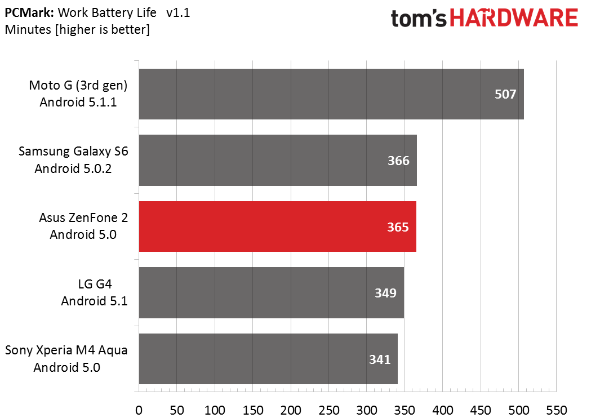
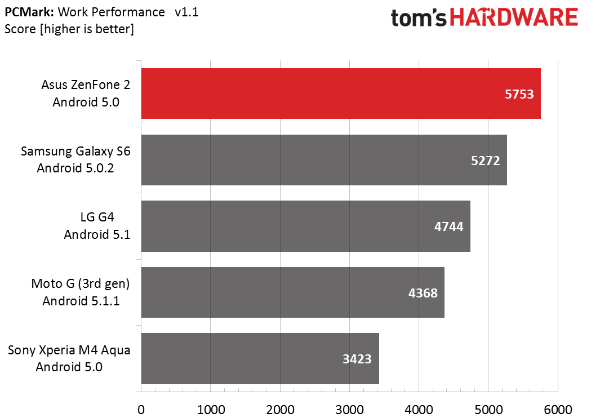
Combining a relatively large battery with a power sipping processor gives the Moto G (3rd gen) a huge advantage in battery life. The ZenFone 2 and the other phones all form a close group around the six-hour mark. If you actually want to use the phone to get work done or pass the time, however, performance is important too. By multiplying the PCMark battery life by the overall performance score, we get a composite metric that gives us an estimate for how much total work can be done on a single charge.
| PCMark Composite Work Score (normalized) | ||||
|---|---|---|---|---|
| Moto G (3rd gen) | ZenFone 2 | Galaxy S6 | LG G4 | Xperia M4 |
| 100% | 94.8% | 87.1% | 74.8% | 52.7% |
The Moto G’s long-lasting battery gives it the lead; you can get a lot done with the Moto G before you need to charge it again. The ZenFone 2’s excellent performance and good battery life make it a close second, beating the more expensive S6 and G4.
The score in this test accounts for both battery life and performance under CPU-intensive workloads. Both the Moto G (3rd gen) and ZenFone 2 rise to the top once again just like they did in our PCMark composite work score. This time, however, the ZenFone 2 holds a slight lead.

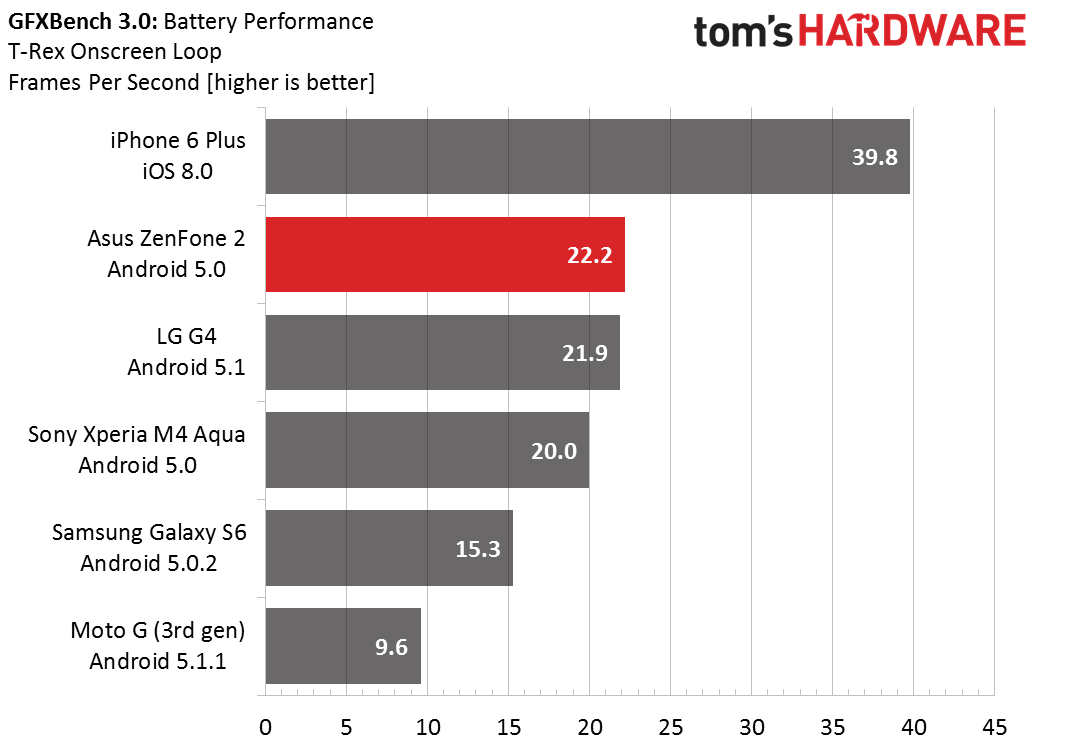
The GFXBench 3.0 battery test focuses on the GPU and is an indicator of battery life during intense gaming. It also effectively gauges a device’s ability to dissipate heat.
Once again, the Moto G outlasts the other phones by a significant margin, but only because its scaled-back GPU delivers less than half the performance of the other devices. The ZenFone 2 strikes a good balance between performance and longevity, both lasting longer and performing better than the Galaxy S6.
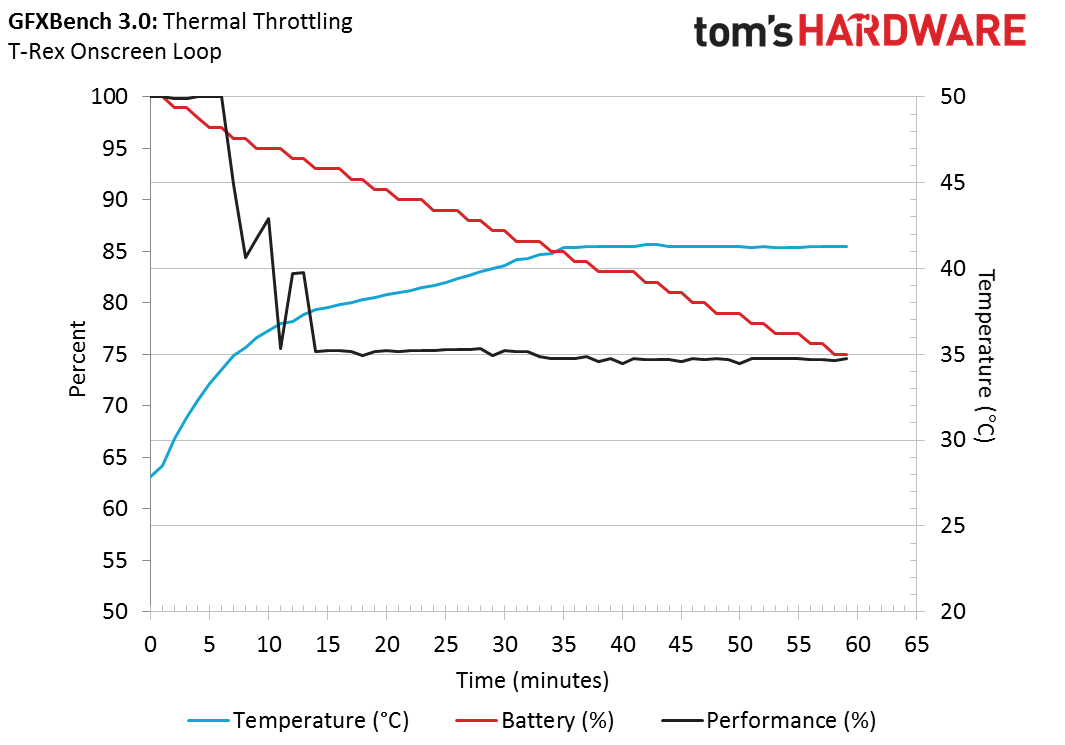
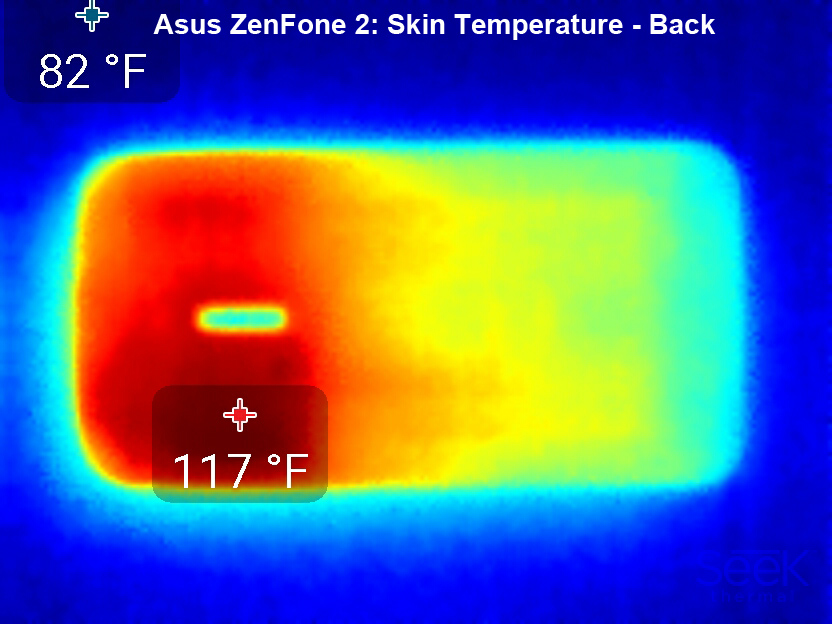
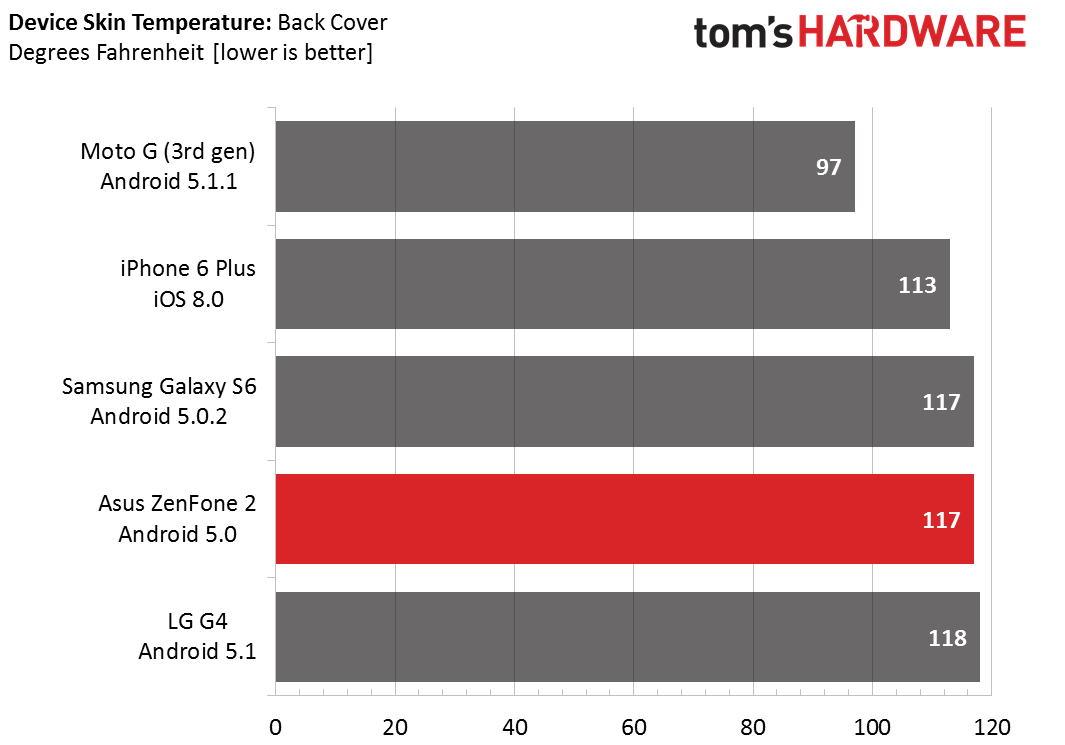
About six minutes into the GFXBench battery test, the ZenFone 2 starts throttling its GPU frequency due to the increase in temperature. GPU performance declines to 75% of the peak level by the 14 minute mark and remains there for the duration of the 60 minute test.
Get Tom's Hardware's best news and in-depth reviews, straight to your inbox.
The skin temperature on the back of the ZenFone 2 peaks at 117 °F, which is in the same range as other high-performing devices. Looking at the thermal image, we can see a buildup of heat in the upper half of the phone. The inability to readily conduct and dissipate heat is one of the drawbacks of its all-plastic construction. The iPhone 6 Plus’ all-aluminum body functions better as a radiator, allowing its more powerful GPU to keep running at peak frequency without throttling.
The combination of a 3000mAh battery and the Atom Z3580 SoC prove to be a good combination for the ZenFone 2, striking a good balance between battery life and performance. This is most evident in PCMark’s real-world work scenarios, where it pulls ahead of several higher-priced devices. While not shown in our charts, the Galaxy Note 4 lasts longer on a charge, but the ZenFone’s higher performance gives it the edge in our composite work score and delivers a better user experience while using it — exhibiting smoother scrolling and fewer pauses overall.
Current page: Battery Life And Thermal Throttling
Prev Page GPU And Gaming Performance Next Page Conclusion-
wtfxxxgp I like the look. I love the price. Seems like a gem of a phone if good value is more important to you than the latest and greatest tech. I wonder if it'll be available here in South Africa...Reply -
MasterMace 2 things that ding the phone before it even started: locked battery, 1080p screen. The LG G4 and Galaxy S6 both have 1440p screens. The LG G4 has a removable battery.Reply -
edwd2 Reply2 things that ding the phone before it even started: locked battery, 1080p screen. The LG G4 and Galaxy S6 both have 1440p screens. The LG G4 has a removable battery.
Yeah, but the G4 and S6 also cost a whole lot more. Not to mention that the G4's A418 has trouble powering that 1440p res while the G6430 is just fine with a 1080p screen.
And what does LG have to offer in the $200 price range? The LG G-Stylo runs a crappy SD410 and 720p display. -
g-unit1111 I wish we'd embrace the concept of dual SIMs and unlocked phones more here in the States. This is a very nice phone for the price and more carriers should be able to use it, right now it seems like only AT&T and Verizon can use it, leaving T-Mobile and Sprint out of it.Reply -
PC98226 Great review. I was looking for your comments re: this device's ability to maintain wireless connectivity. I have been using the 4GB version of this phone for several months now. While I found it to have a VERY snappy speed, I experienced some quirks re: it connectivity. I would frequently have to check why the phone stalled trying to open up a web site only to realize that it had switched the connection from my WiFi to my wireless printer. This happened so frequently that it slowed me down re: productivity. I suspected there was some type of software glitch that needed to some attention. So, until that happens, I have returned to using my Moto X (2014). During your testing of this device, did you see or experience anything like the above?Reply -
MRCPU I own one of these, and I really like it. Asus has been very good about pushing fairly regular software updates, much faster than any carrier. For a time, it seemed like updates were hitting like clockwork about every 2 weeks.Reply
However, the one downside to this phone is the *massive* amount of bloat. The author touches on it a bit, but did not convey how much pure crap resides on this phone stock.
However, there are many fixes available to that problem. A quick google for debloating scripts will get you headed in the right direction.
My only other gripe is that mp3-based notification tones don't seem to consistently stop if you like touch the screen, or acknowledge the notification, you can't flip the phone over to silence it like on the Galaxy series. But these are minor nits.
I get a full day of usage out of my battery, the quickcharge is nice, and for 300 bucks, the extra features of the other phones aren't appealing enough.
I recommend this phone to anybody. -
PC98226 Reply16526515 said:"....However, the one downside to this phone is the *massive* amount of bloat. The author touches on it a bit, but did not convey how much pure crap resides on this phone stock."
Yes, I totally agree re: the massive amount of crapware pre-installed on this device. I tried to either uninstall or disable all that I could (nearly 33 apps in all) before I installed the apps I wanted to use. Now, these apps no longer auto-update so that is a help.
-
GoZFast I owned this phone from newegg since late May and I have to say that its the best phone I have ever had over LG, Samsung, iPhone, Blackberry etc The kernel is 64 bit but not the OS. Asus are working on a completely x86_64 Intel OS based on Android/Linux source code. Some apps are not x86 compatible yet but when they are, they run much more efficient than ARM. Its price of 299$ for the top 4Gb RAM model is too good for what it offers and if you even want more, you can join ZenTalk beta forum. With beta firmware, the phone is faster and battery lasts longer, never had an issue with beta firmware so far. This is also the coldest phone I have had, much colder than G3 and G2. Anything over 1080p in a 5'' device is pointless and will just consume more battery, create more heat and put a high load on the GPU. What also amazed me is that you can run 128Gb SDcards EVEN if the specs says 64Gb (Lexar 633x) The 18W 9V2A charger is faster than Samsung's 9V1.67A adaptive charger. Here is my newegg review, basically, the Atom CPU beats the SD810 and S6 in single threaded performance (Floating-point and Integer), it only loses in multithread (Hence, higher Antutu score) because its rivaling 8 cores so imaging doubling this in a future phone! I also doubt that playstore apps will take advantage of 8 cores like Anututu and hence, their higher score doesn't mean that 4 core or less apps will be faster. Intel can easily add more cores with 14nm but other are already 8 cores with 14nm and it will be very hard to increase performance with more than 8 cores. Intel Core M with Intel GPU in tablets is 3.5W while the Atom is 2.2W. If Intel can find a way to integrate it into smartphone, it will be a heck of a phone considering that it gets ~3000pts in PassMark similar to Intel Core i5-3317U or an AMD A10-5757M.Reply
Pros: Intel 64bit 3D 22nm Quad 2.33Ghz
4GB Ram, did I underscore its speed?
This outperforms all current cellphones (yes, faster than snapdragon 810) and have lots of headroom for improvement on intel architecture with more instruction sets for programming. We will probably see this device quad boot; android:windows:linux:mac os x
Lots of potential.
9v 18w charger! Higher than 12w ipad lol
Cons: PowerVR G6430, same architecture as iphone 6+ but this intel extracts more gpu power vs dual-core 1.4ghz apple.
Wish it had intel graphics which is up to 4x more powerfull than Adreno 430, highest current mobile gpu. Intel graphics would also throw more compatibility and instruction sets into the table.
14nm and 3200mah maybe?
Camera could be better (4k?) but not a fan of photography, it does what it says.
Other Thoughts: For more battery life, put screen into reading mode and dim it as the default setting is very bright. Also, there is option to powersave in settings. You can also remove unnecessary apps, use system app remover for system apps (Not needed with Beta firmware) Getting better battery than my old g3.
p.s: With beta firmware, you can disable/uninstall any app you want, even system apps without root. Root will break OTA and live beta updates. Many of these apps are actually useful though. Also, I found that Nova launcher decreased RAM usage by 80Mb and its snappier (Doesn't need root) -
fyend Asus rivals Samsung with the amount of uninstallable crapware they preload on their phones. If you're planning to root, that's fine you can remove it all, but if not you're stuck with a lot of junk.Reply
